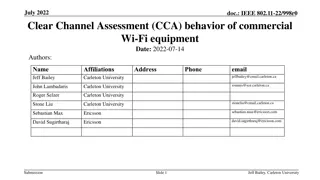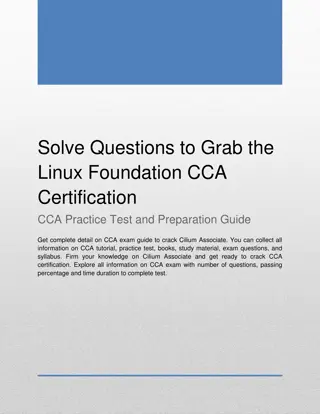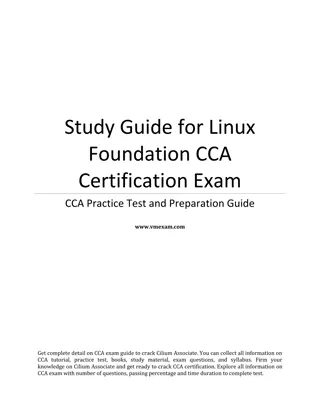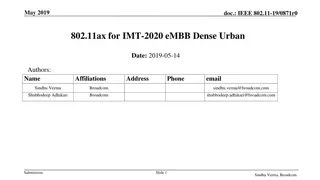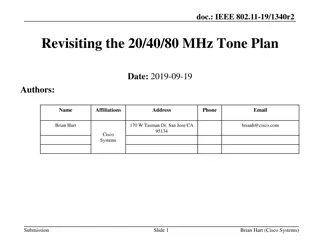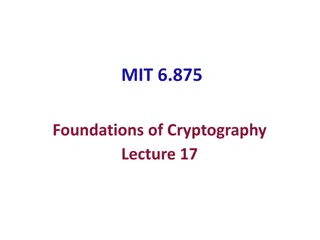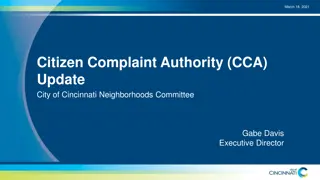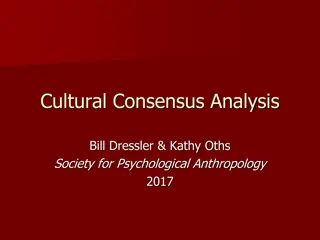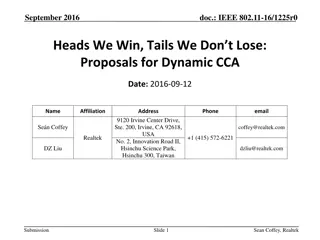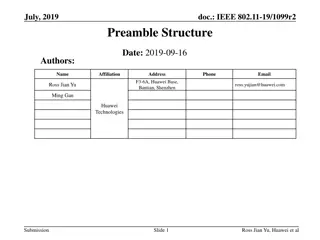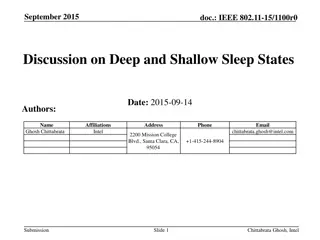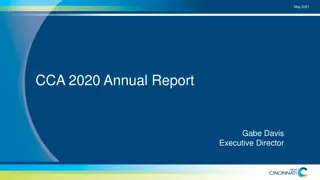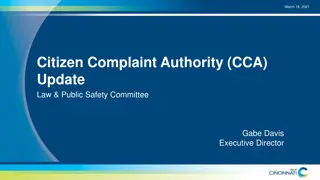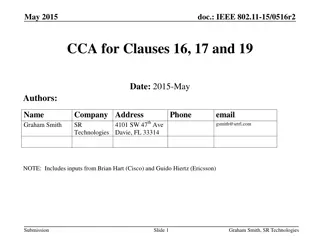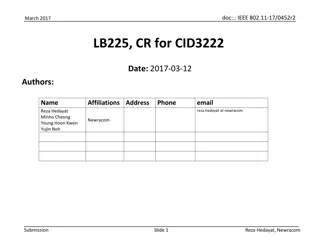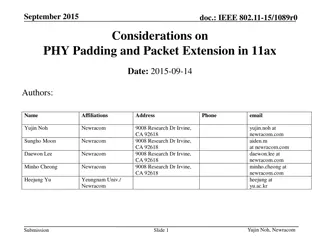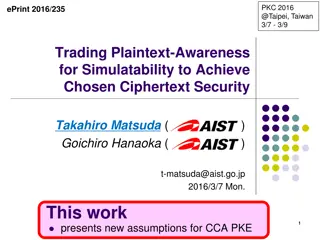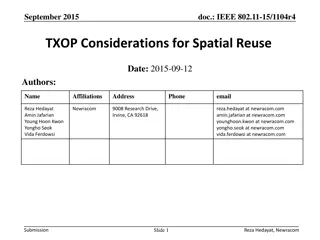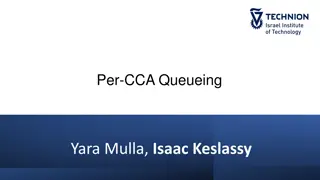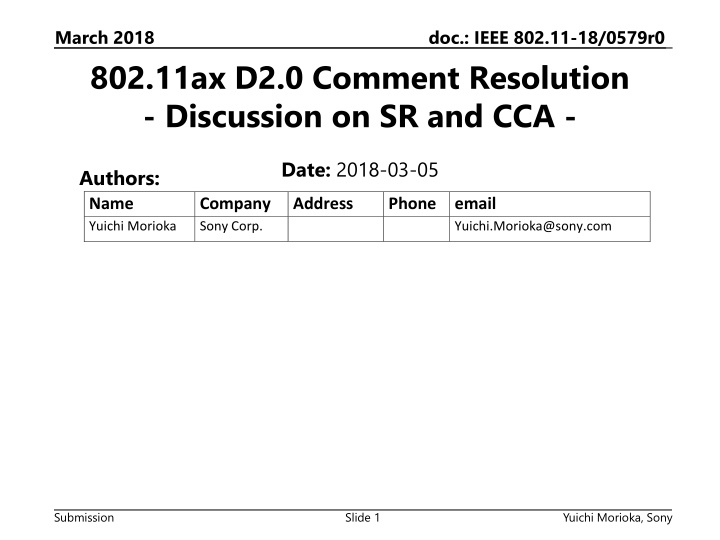
IEEE 802.11-18/0579r0 Comment Resolution Discussion on SR and CCA
Highlighting missing language on CCA behavior impacting the efficiency of SR mechanism in IEEE 802.11ax D2.0. Addresses requirements for BUSY indication, OBSS_PD-based SR, CCA IDLE state, and impact on signal detection. Contains related comments and an example scenario for reference.
Download Presentation

Please find below an Image/Link to download the presentation.
The content on the website is provided AS IS for your information and personal use only. It may not be sold, licensed, or shared on other websites without obtaining consent from the author. If you encounter any issues during the download, it is possible that the publisher has removed the file from their server.
You are allowed to download the files provided on this website for personal or commercial use, subject to the condition that they are used lawfully. All files are the property of their respective owners.
The content on the website is provided AS IS for your information and personal use only. It may not be sold, licensed, or shared on other websites without obtaining consent from the author.
E N D
Presentation Transcript
March 2018 doc.: IEEE 802.11-18/0579r0 802.11ax D2.0 Comment Resolution - Discussion on SR and CCA - Date: 2018-03-05 Authors: Name Yuichi Morioka Company Sony Corp. Address Phone email Yuichi.Morioka@sony.com Submission Slide 1 Yuichi Morioka, Sony
March 2018 doc.: IEEE 802.11-18/0579r0 Introduction In this contribution, we highlight some missing language on CCA behavior which could make the SR mechanism introduced in 11ax D2.0 inefficient Submission Slide 2 Yuichi Morioka, Sony
March 2018 doc.: IEEE 802.11-18/0579r0 Related Comment on 11ax D2.0 CID Clause Number(C) Page(C) Line(C) Comment Proposed Change 14119 27.9.2.4 295 58 There is no requirement on when the STA that issued the CCARESET.request primitive during the inter- BSS PPDU re-issues the BUSY indication. If there is no such requirement, multiple SR transmissions will just collide with one another. Define requirement on how the HE STA issues the BUSY indication when a) the inter-BSS is still being sent and b)another HE STA starts an SR PPDU transmission. Similar concern raised in CID14289 Submission Slide 3 Yuichi Morioka, Sony
March 2018 doc.: IEEE 802.11-18/0579r0 What is OBSS_PD based SR? From 802.11 D2.0 OBSS_PD based SR (and other SR mechanisms) allows the STA return to CCA IDLE while the OBSS PPDU is being transmitted Submission Slide 4 Yuichi Morioka, Sony
March 2018 doc.: IEEE 802.11-18/0579r0 What is the requirement during CCA IDLE? From 802.11-2016 During CCA IDLE state, the STA is mandated to detect an OFDM transmission that arrives at -82dBm in any SINR condition * Note: in other PHY Clauses, this requirement is imposed when the medium is "in an otherwise idle channel , however this condition is omitted here Submission Slide 5 Yuichi Morioka, Sony
March 2018 doc.: IEEE 802.11-18/0579r0 How does this effect SR? Will an HE STA that returned to CCA IDLE during OBSS PPDU, be able to detect another signal that arrives above -82dBm, in any SINR condition as required by the specification? Unlikely if SINR is low Let s look at an example Submission Slide 6 Yuichi Morioka, Sony
March 2018 doc.: IEEE 802.11-18/0579r0 Example Scenario STA1 AP A 98dB loss STA2 STA1 and STA2 are both connected to AP A The loss between STA1 and STA2 is 98dB If STA1 transmits at 21dBm, STA2 will receive at -77dBm If STA1 transmits at 19dBm, STA2 will receive at -79dBm Both above CCA Thresh. Submission Slide 7 Yuichi Morioka, Sony
March 2018 doc.: IEEE 802.11-18/0579r0 Example Scenario STA1 -80dBm OBSS STA AP A -80dBm STA2 STA1 and STA2 detects an OBSS PPDU at -80dBm According to the OBSS_PD rule STA1 and STA2 may go back to CCA IDLE if they lower their TxPower from 21dBm to 19dBm Submission Slide 8 Yuichi Morioka, Sony
March 2018 doc.: IEEE 802.11-18/0579r0 Example Scenario STA1 19dBm AP A 19-98= -79dBm -80dBm STA2 STA1 wins the contention and start transmission at 19dBm to AP A STA2 receives STA1 at -79dBm which is above the CCA Threshold However STA2 can NOT detect STA1 because it is already experiencing -80dBm interference from the OBSS STA Submission Slide 9 Yuichi Morioka, Sony
March 2018 doc.: IEEE 802.11-18/0579r0 How likely will intra-BSS collision occur during SR? PHY Header Data OBSS PPDU 4000usec PHY Header Data STA1 DIFS 34usec PHY Header Data STA2 Contention Window DIFS34+CW225xSlot9=2059usec If we assume OBSS PPDU is 4msec, and STA1 and STA2 are using Contention Window=255 (4 collisions), there is 100% probability of collision because min/max wait time both fall within the OBSS PPDU Collision is likely because all STAs start contention at the same time Submission Slide 10 Yuichi Morioka, Sony
March 2018 doc.: IEEE 802.11-18/0579r0 FAQ: Doesn t this happen already? YES, but with significantly lower probability If there are two OBSS STAs(STA A and B above), 1. that are hidden from one another 2. which both fall within above PD (-82dBm), below ED(-62dBm) range, 3. transmit PPDUs that partially overlap then, two intra-BSS STAs may not able to detect each other, causing collision However, it only takes one OBSS PPDU in SR case, as discussed in prev. slide The problem existed before SR but surfaced extremely rarely Submission Slide 11 Yuichi Morioka, Sony
March 2018 doc.: IEEE 802.11-18/0579r0 Conclusion The document depicted an omission to the baseline spec related to CCA Because of this omission, STAs will be unable to comply with the baseline spec in low SINR conditions Because of this omission, HE STAs are very likely to cause intra-BSS collision during SR transmission opportunity Submission Slide 12 Yuichi Morioka, Sony
March 2018 doc.: IEEE 802.11-18/0579r0 Possible Remedy 17.3.10.6 CCA requirements Modify the third paragraph as follows: For a non-HE STA, tThe start of a valid OFDM transmission in an otherwise idle channel at a receive level greater than or equal to the minimum modulation and coding rate sensitivity (-82 dBm for 20 MHz channel spacing, -85 dBm for 10 MHz channel spacing, and -88 dBm for 5 MHz channel spacing) shall cause CS/CCA to detect a channel busy condition with a probability > 90% within 4 us for 20 MHz channel spacing, 8 us for 10 MHz channel spacing, and 16 us for 5 MHz channel spacing. For an HE STA, the start of a valid OFDM transmission at a signal-to-noise ratio greater than or equal to 6 dB and at a receive level greater than or equal to the minimum modulation and coding rate sensitivity (-82 dBm for 20 MHz channel spacing, -85 dBm for 10 MHz channel spacing, and -88 dBm for 5 MHz channel spacing) shall cause CS/CCA to detect a channel busy condition with a probability > 90% within 4 us for 20 MHz channel spacing, 8 us for 10 MHz channel spacing, and 16 us for 5 MHz channel spacing. Submission Slide 13 Yuichi Morioka, Sony
March 2018 doc.: IEEE 802.11-18/0579r0 Strawpoll Do you think a remedy is necessary? Yes some standardized rule for signal detection dependent on SINR is necessary (an example in slide 13) No keep the spec as is Don t Care I don t want to hear about SR anymore Submission Slide 14 Yuichi Morioka, Sony

